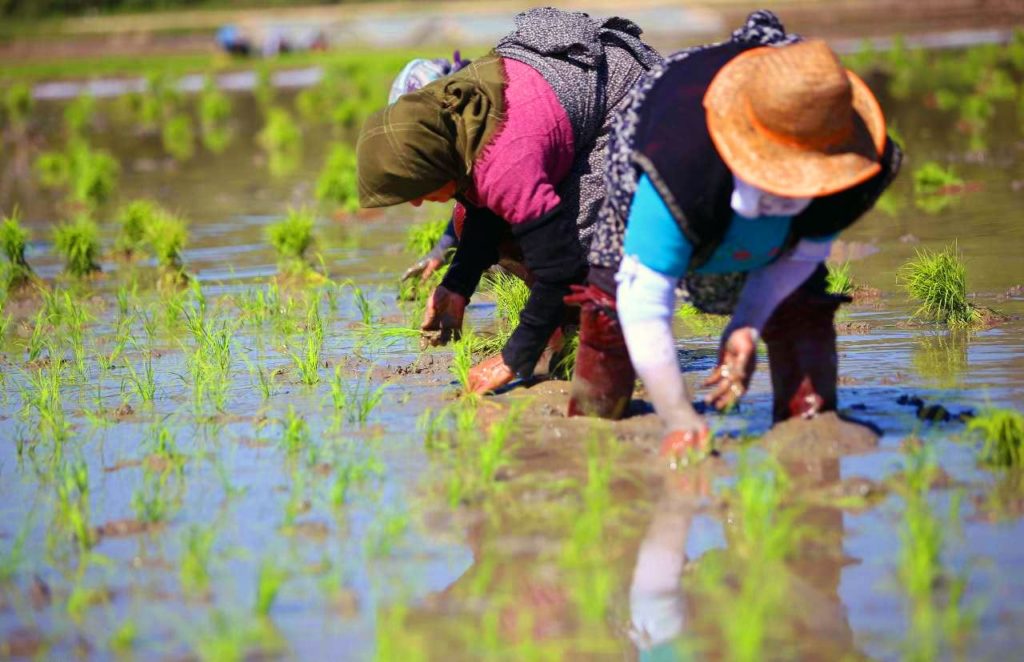February 18, 2022
by Warren L. Nelson

Despite Iran’s severe water shortages, the regime has decided to invest $3 billion in an effort to make the country self-sufficient in rice, the crop that demands the most water.
According to the Mehr news agency, on January 28 Agriculture Minister Javad Sadatinejad announced the five-year project, agreed by the ministry and Khatam-ol-Anbiya, the Pas-daran’s engineering arm. The project is to be resourced by bartering oil, Mehr said.
Many in Iran have questioned the Pasdaran’s involvement in economic mega-projects. Clearly, the new Raisi Administration doesn’t question that.
The agriculture minister didn’t say where all the required water would come from. He made the announcement in Gilan province, on the Caspian shoreline, where Iran has its most abundant water supplies. The province is already a major rice producer.
The project is a clear nod to the revolutionary goal of autarky or self-sufficiency in everything of great importance to Iran. Wheat has been the major agricultural product in which the regime has sought to achieve self-sufficiency until now. It did so briefly. But it is back this year to being one of the world’s major wheat importers because the drought has reduced wheat output sharply.
Revolutionary theorists argue that bigger powers will seek to bring Iran to heel by refusing to sell it food, thus requiring Iran to become self-sufficient. In 40 years since the revolution, however, no country has refused to sell Iran food.
India and Thailand are the world’s largest rice exporting countries, followed by Vietnam, Pakistan, China and the United States. These six countries account for more than four-fifths of the total volume of annual rice exports. Iran has long imported rice from all these countries except the United States.
In recent years, Iran has imported between 1.1 million metric tons and 1.4 million of rice each year. Sadatinejad said Iran has the potential to be self-sufficient in the grain. He said it is one of the Raisi Administration’s top priorities to achieve that self-sufficiency.
The country has now hit a rice emergency, as supplies are low and prices are rising. On February 3, there was an emergency meeting of the Food Security Headquarters, which then ordered the expedited import of 200,000 metric tons of rice and 100,000 tons of potatoes. Until now, Iran has normally been self-sufficient in potatoes.
Per capita rice consumption in Iran is around 35 kilograms (77 pounds), putting overall consumption, including by agro-food industries, at 3.5 million tons. The highest output, achieved in 2018, was 1.9 million tons. (The US has never reached 11 kilos of per capita rice consumption in any year.)
Major production in Iran is concentrated in the Caspian coastal provinces of Gilan, Mazandaran, and Golestan, which together produce over 75 percent of the rice grown in Iran.
Other provinces, including Esfahan, Khuzestan, and Fars, produce rice on a small scale. Almost all these provinces have been hit by drought in the past few years and the ministry has banned rice cultivation in some provinces, including Golestan, which is among the provinces with the highest precipitation, according to Iran International.
A Tehran Times columnist warned last July of the peril posed to Iran by the expanded cultivation of rice. M.A. Saki said growing rice on Iranian land other than territories bordering the Caspian Sea “is like shooting oneself in the foot.”
Despite Iran’s water scarcity, the cultivation of rice has been spreading in around 20 provinces across the country “like a pandemic,” he wrote.
“The massive consumption of surface waters to irrigate paddy fields or other water-intensive crops like onion or watermelon has even disrupted the ecosystem in certain areas. However, officials, especially those in the ministries of agriculture and energy, are either ignorant of the short-term and long-term consequences of this move or they are purely careless,” he wrote.
The state-run Islamic Republic News Agency (IRNA) published a series of photographs in September 2020 showing that farmers were cultivating rice in the Qasr-e Qand region of Sistan va Baluchestan, which is famous as a desert province. IRNA reported that rice was cultivated twice a year in the region.
The market prices fetched by rice in comparison to other crops are so enticing that it is very difficult to convince farmers to turn to other alternative crops, said Saki. “It is so profitable that some farmers dig wells without receiving a permit from the Ministry of Energy,” he added.
In 2013, the secretary of Iran’s Rice Producers’ Association, Jamil Alizadeh, said self-sufficiency in rice production was not logical given that the crop requires intensive irrigation. Alizadeh said the country had 630,000 hectares of rice paddies but irrigation could be considered assured for only 520,000 with remaining crops vulnerable to drought.
Iran is normally among the top five rice importers in the world and was the single largest importer in 2013, 2018 and 2019.
Like much of the wider region, Iran has faced serious drought for years, with water shortages affecting around one-fourth of Iran’s cities. Critics also blame water-intensive industries, like steel refining, and water stress had led to protests in many cities, especially in Khuzestan province.